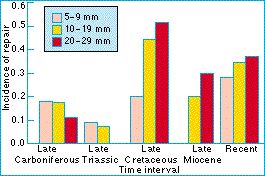Coevolution - What is an evolutionary 'arms race' ?

Prey
The most obvious measure for escalation in prey defences would perhaps be shell thickness, but the best evidence is for other characters.
• Shell repair
When a mollusc is non-lethally attacked, it repairs the damage to its shell and the repair pattern can be observed in the shell. Proportions of shells showing signs of repair have been measured in several fossil faunas, and the graph opposite shows increasing amounts of repair over time. This may mean that the prey have been suffering higher frequencies of predatory attacks over evolutionary time. (Logically it could also mean - though this is perhaps unlikely - that the predators have de-escalated from forms that destroyed their prey to forms that sometimes merely injured them!)
Figure: incidence of repair at five successive time periods, for shells divided into three size classes. Note (i) the incidence of repair is higher in more recent times. (ii) Larger shells show a relatively high incidence of repair compared with small shells. From Vermeij (1987).
| Next |



